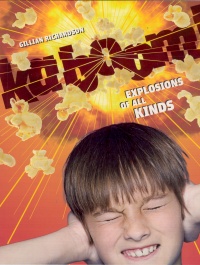| ________________
CM . . .
. Volume XVI Number 11. . . .November 13, 2009
excerpt:
Explosions occur when energy is released rapidly and pushes against a barrier of some sort or when highly flammable material suddenly ignites, producing heat, light and gases. Natural or man-made, large or small, explosions can be destructive or constructive or a little of both. One example is a volcanic eruption. It can destroy homes and habitats, but it can also form new areas of land by means of cooled lava. KABOOM! looks at the scientific principles behind a variety of explosions and presents them in an engaging way. The book is divided into two main sections, each having three chapters. Section one covers natural explosions occurring on Earth (volcanoes, geysers, and coal mine methane), in outer space (supernovas, gamma ray bursts and solar flares) and in the plant and animal world. In this last chapter of the section, readers will learn about exploding seed pods, some of which can scatter seeds up to 40 metres away, and others whose bursts have been clocked at 100 kilometres per hour. The second section discusses explosions created by humans. Topics covered include destructive explosions, such as those caused by gunpowder, dynamite and bombs, and constructive explosions, such as building demolitions via implosion, the building of the Panama Canal, and the creation of monuments such as Mount Rushmore. The final chapter, entitled "Just for Fun," features fireworks and recent developments which make fireworks hotter, faster, and more colorful, and special effects in movies. These include fake blood capsules and squibs, small explosive devices which make noise, smoke and sparks. Following all but one of the chapters is an account of an explosive event which made headlines, two examples being the Halifax Explosion of 1917, and the Hindenburg tragedy of 1937. Fun fact sections, providing additional information, appear throughout the book.
Highly Recommended. Gail Hamilton is a recently retired teacher-librarian in Winnipeg, MB.
To comment
on this title or this review, send mail to cm@umanitoba.ca.
Copyright © the Manitoba Library Association. Reproduction for personal
use is permitted only if this copyright notice is maintained. Any
other reproduction is prohibited without permission.
NEXT REVIEW |
TABLE OF CONTENTS FOR THIS ISSUE
- November 13, 2009.
AUTHORS |
TITLES |
MEDIA REVIEWS |
PROFILES |
BACK ISSUES |
SEARCH |
CMARCHIVE |
HOME |
